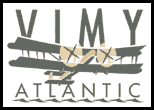England to Australia Flight
Part VIII: Crash Landing!
by Peter McMillan
Back in the air, I couldn't help wondering what the scooter
juice was doing to our engines. I wanted to kick myself
for letting my impatience get the better of my good sense.
As we got closer to Delhi, however, I began to worry that
we wouldn't have enough of the gas.
After draining three of our four fuel tanks, I shifted
to our last-chance tank. The final 15 miles were tense.
About a mile from the airport, at 2,000 feet, I saw the
starboard fuel pressure gauge plummet. I knew we could
probably glide to the end of the runway, but I managed
to restore partial power by tipping the nose down to slosh
the fuel around. We landed and sputtered to a stop.
Our ten hour flight to Calcutta the next day was less
harrowing. Flying over endless green paddies, we passed
just north of Allahabad, where the original Vimy team
had been delayed by a territorial bull.
Ross Smith described the incident:
I frightened him for the moment by a roar from the
engines. Evidently he took the roar for a challenge,
and stood in front to the Vimy, pawing the ground and
bellowing defiantly. At this point a boy scout rushed
out from the crowd to move the monster, and, much to
the amusement of ourselves and the crowd, the bull changed
his intentions and turned on the hero. Our brave toreador
retreated to the fence, pursued by the bull.
A different kind of monster was waiting for us in Calcutta
when we arrived on Day 21. The plague had caught up with
us again. More and more nations around the world, including
most of India's neighbours, were refusing to let flights
from India land on their soil. At least half of India's
international airliners had been grounded.
Mick Reynolds and Ian Snell felt strongly that we should
leave as soon as possible for Chittagong, Bangladesh.
Exhausted by the flight from Delhi, however, Lang, Dan,
and I needed to rest. The next morning at four, everyone
else gathered at the airport, only to spend three hours
arguing with immigration officials.
Eventually things were sorted out, and the two chase
planes were allowed to take off. They'd been up barely
half an hour, though, when the air traffic controller
in Calcutta radioed to say that permission to land at
Chittagong had been withdrawn because of the plague. Rather
than go back, they decided to keep flying all the way
to Yangon (formerly Rangoon) in Myanmar. It would take
every drop of fuel on board both planes.
As they approached the Myanmar border, an officer in
Yangon radioed to tell our pilots that they could not
land in that city either. There was only one thing to
do.
"I'm sorry, Yangon, I couldn't hear you," Mick
said into the Nomad's microphone. "We seem to be
having a problem with our radio."
"Same difficulty here," said Ian in the Islander.
"Our radio's malfunctioning."
It was a desperate ploy, but with their diminishing fuel
supplies our group had nowhere else to go. Only after
the two planes were closing in on Yangon, did our pilots
manage to "fix" the radios and ask for permission
to land.
"We weren't sure what kind of reception we'd receive,"
Bev Kidby said later. "But they treated us all very
well. We were picked up in a bus, taken off for brief
medical examinations, pronounced free of the plague, and
released."
Lang, Dan, and I left Calcutta at dawn the next morning
to catch up with the others. At the airport we had to
wake up a young customs man, who groggily attempted to
stamp our flight plans. The first four stamp pads he tried
were bone dry, so it was good that he had a drawer full
of them. In no time at all we were back up in the air
and heading for Myanmar, with its spinach green jungle,
hilly terrain, rocky outcroppings and golden temples.
Symptoms of trouble with the starboard engine began to
appear almost a week before our forced landing in Sumatra.
When we took off from Yangon on Day 24, the motor sounded
as if it was missing on a cylinder. As we were leaving
Bangkok, the engine was so sluggish I wasn't sure we'd
make it over downtown buildings.
That afternoon, after dodging thunderstorms in the Gulf
of Thailand, we made an unscheduled landing on the island
of Langkawi in Malaysia because the engine started vibrating
badly and the needle on the tachometer began to swing
like a metronome.
Replacing a spark plug got us as far as Singapore, where
Ian Snell suffered severe abdominal pains that put him
in the hospital. We had all been hit with stomach ailments
at one point or another, but Ian's problems were later
diagnosed as cholera. Two days later the Vimy broke down
over Lampung Province on Sumatra, and we belly flopped
into the rice field, 140 miles short of Jakarta.
|


